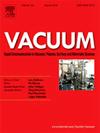Study on thermoelectric properties and atomic-scale mechanism of B-site molybdenum-modified La0.1Sr0.9TiO3
IF 3.8
2区 材料科学
Q2 MATERIALS SCIENCE, MULTIDISCIPLINARY
引用次数: 0
Abstract
Extensive studies on strontium titanate thermoelectric materials have shown that their poor conductivity results in a low ZT value. However, elemental doping can effectively improve the thermoelectric properties of these materials. In this study, a two-step sintering process was applied, using physical mixing to introduce 1 % molybdenum powder as a modification to the lanthanum-doped strontium titanate solid powder (La0.1Sr0.9TiO3). The obtained sample exhibited a maximum conductivity of 7830 S/m, with a maximum ZT of 0.12. Furthermore, this study combined experimental data with first-principles simulation calculations to elucidate the mechanism at the atomic scale. The incorporation of Mo6+ in place of Ti4+ at the B-site by molybdenum (Mo) adds two free electrons, leading to an elevated carrier concentration. This change concurrently reduces the Fermi level of the material and improves mobility, collectively resulting in a substantial increase in electrical conductivity. Phonon simulation indicated that Mo doping increased structural defects, thereby reducing lattice thermal conductivity. This significant enhancement in electrical conductivity and decrease in lattice thermal conductivity collectively increased the ZT value of the material.
B 位钼改性 La0.1Sr0.9TiO3 的热电性能和原子尺度机理研究
对钛酸锶热电材料的广泛研究表明,其导电性差导致 ZT 值较低。然而,元素掺杂可以有效改善这些材料的热电特性。本研究采用两步烧结工艺,通过物理混合将 1% 的钼粉引入掺杂镧的钛酸锶固体粉末(La0.1Sr0.9TiO3)中作为改性剂。所得样品的最大电导率为 7830 S/m,最大 ZT 为 0.12。此外,该研究还将实验数据与第一原理模拟计算相结合,以阐明原子尺度上的机理。钼(Mo)在 B 位加入 Mo6+ 取代 Ti4+,增加了两个自由电子,导致载流子浓度升高。这一变化同时降低了材料的费米级,提高了迁移率,从而大大提高了导电性。声子模拟表明,掺杂钼增加了结构缺陷,从而降低了晶格热导率。电导率的显著提高和晶格热导率的降低共同提高了材料的 ZT 值。
本文章由计算机程序翻译,如有差异,请以英文原文为准。
求助全文
约1分钟内获得全文
求助全文
来源期刊

Vacuum
工程技术-材料科学:综合
CiteScore
6.80
自引率
17.50%
发文量
0
审稿时长
34 days
期刊介绍:
Vacuum is an international rapid publications journal with a focus on short communication. All papers are peer-reviewed, with the review process for short communication geared towards very fast turnaround times. The journal also published full research papers, thematic issues and selected papers from leading conferences.
A report in Vacuum should represent a major advance in an area that involves a controlled environment at pressures of one atmosphere or below.
The scope of the journal includes:
1. Vacuum; original developments in vacuum pumping and instrumentation, vacuum measurement, vacuum gas dynamics, gas-surface interactions, surface treatment for UHV applications and low outgassing, vacuum melting, sintering, and vacuum metrology. Technology and solutions for large-scale facilities (e.g., particle accelerators and fusion devices). New instrumentation ( e.g., detectors and electron microscopes).
2. Plasma science; advances in PVD, CVD, plasma-assisted CVD, ion sources, deposition processes and analysis.
3. Surface science; surface engineering, surface chemistry, surface analysis, crystal growth, ion-surface interactions and etching, nanometer-scale processing, surface modification.
4. Materials science; novel functional or structural materials. Metals, ceramics, and polymers. Experiments, simulations, and modelling for understanding structure-property relationships. Thin films and coatings. Nanostructures and ion implantation.
 求助内容:
求助内容: 应助结果提醒方式:
应助结果提醒方式:


